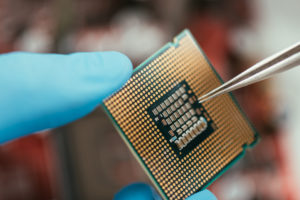Nanotechnologies refer to structures in the size range between one and one hundred nanometers. “Nano” is ancient Greek for “dwarf” and in fact a nanometer is only one billionth of a meter – or in other words 10 to the power of minus nine meters.
In relation to a millimeter, a nanometer is roughly the size of a soccer compared to the earth. On this scale, the properties of a body’s volume are less important than its surface properties. This results in an enormous physical scope of functions for new structures, systems and devices. For example, nanotechnology can be used to turn glass into a binder. Ceramics can be made transparent and metal can be turned into a color pigment. Nanocarbon fibers can withstand extreme tensile forces, to name but a few. So these technologies are moving to the atomic level. The hope is to give materials and objects new innovative properties through these tiny structures and changes. In the best case, this will at the same time pave the way for completely new possibilities and areas of application. From quantum physics and all materials sciences to electronics, computer science and chemistry as well as various areas of micro-, molecular and cell biology, almost all sectors of the economy are involved in research at the nanometer level and its achievements. The ideas for this are often first and foremost provided by nature.
Models from nature
You don’t have to search long to discover models from nature. Every organism, not only the human organism but also that of every animal, plant and bacterium consists of astonishingly well-functioning nanoparticles. Tiny little motors such as chloroplasts, ribosomes and also the “smallest wheel in the world”, the ATP synthase, are among them. The latter works in principle similar to a battery charger. Life would not be possible without these small natural nanostructures.
The Lotus Flower Effect
The best known invention in the field of nanotechnologies is probably the lotus blossom effect copied from nature. These plants allow raindrops to roll off, but dirt cannot stick to them either. The reason is the surface quality of the leaves. Water, dirt and also insects have a hard time to adhere or settle down. The lotus blossom effect is used, for example, on surfaces such as kitchen cabinets to keep pests away (they simply slip off), or in the automotive industry, where it is primarily used to protect the bodywork. This “nano sealing” is a wafer-thin layer that is virtually self-organizing. This means that on the one hand it bonds firmly to the surface and on the other hand it creates a non-stick effect in the other direction.
Nanotechnology already everywhere?
Further examples of nanotechnologies already in use are
Sun creams with their protection against ultraviolet light
Paints and varnishes with special color properties and protection against mold and dirt
Aluminium particles in parquet and furniture varnishes to prevent scratching too quickly
Sports socks and clothing with nanosilver, which fights bacteria and their odours
antibacterial surfaces to protect against pathogens of infectious diseases in hospital and care
Foods like ketchup contain viscous silicon dioxide
Nanotechnology as a chance for the future?
The field of nanotechnology research is still very young and it is therefore hardly surprising that many experts expect enormous breakthroughs in medicine within the next twenty to thirty years. Above all, it is expected to revolutionize the diagnosis and therapy of diseases.
In the treatment of cancer cells, for example, a so-called hyperthermia procedure is to be used. In this process, metal oxides, i.e. metallic nanoparticles, are introduced into the diseased tissue. These are then heated by means of alternating electromagnetic fields and are intended to eliminate the tumor cells, which are temperature-sensitive compared to healthy body cells.
Further hope for the future
Nanotransport systems should make it possible to target the application of drugs in the body. This is an attempt not only to increase the desired effect but also to minimize undesirable side effects. Nanofilters could be of great value for dialysis patients and make frequent, regular dialysis in the facility unnecessary. Patients would also be spared the ever worsening physical condition that has been experienced until then. All in all, a significant improvement in the quality of life.
In the field of medicine, nanocoatings could be useful for implants whose durability could be significantly extended. Further operations as well as long-term complications could be avoided for the patients.
Nanotechnology as a great danger?
In the visions of the researchers, nanotechnology seems like a magic cure that can make almost anything possible. But the more tempting the promises, the greater the danger from its flip side.
After all, nanoparticles are so small that they can easily pass through various barriers of the body, from the lungs to the bloodstream to the blood-brain barrier. They can penetrate unhindered into body cells and it is still completely unclear what they can trigger.
The desire for testing and labelling
Currently, there are no uniform or even reliable tests for the safety of nanoproducts, which is primarily complained about by BUND. Nor is product labelling currently either mandatory or regulated. So consumers cannot know whether they come into contact with nanoproducts and therefore cannot make a conscious decision.
Undesirable side effects
Experts are particularly concerned about the antibacterial effect of many bathroom cleaners or sportswear. It could be that people react all the more violently to external microorganisms due to the lack of regular contact with them. Possibly these products also destroy an intact skin flora. In addition, there is a risk that the bacteria will adapt to such substances. Such resistance would render these substances ineffective in medicine.
The nanosilver used could also get into the environment and severely disturb various cycles, especially in the water of rivers and lakes. After mercury, it is the second worst poison for many animals and microorganisms living in it.
Nanofood today and tomorrow
It sounds unimaginable and yet it is already reality. Nanofood has been on supermarket shelves for years. One example is ketchups and other viscous sauces that contain silicon dioxide for the desired consistency. Salad dressings contain titanium dioxide as a bleaching agent and various powders are mixed with aluminum silicates to prevent them from sticking together in the bag. The list is long and frightening. After all, few consumers are likely to be aware of what they are eating.
This market will tend to expand considerably. Almost all major food companies are already conducting research in the field of nanotechnology.
Food of the future?
Pizza that turns into a tomato-flavored pizza at 300 watts in the microwave and tastes like spinach pizza at 600 watts is less absurd than it seems. Likewise, there is already chocolate mixed with titanium dioxide, which does not melt easily even in the sun at warm temperatures. It is only a matter of time before low-calorie ice cream or flavor-altering milk become reality. Whether all these foods are really healthy is not known.
Cosmetics with and without nanotechnology
While deodorants have been advertised for years with the fact that they do not contain aluminum salts, various other common and new products continue to be mixed with this and other nanosubstances. A contradiction? Yes and no. Because what the consumer does not know…
One-sided reporting
Nanotechnologies are massively promoted by the German government with tax money. In Germany, as of 2015, there are about 1000 companies with more than 50,000 employees directly or indirectly involved in nanotechnology. A not insignificant size.
It is therefore not surprising that the reporting on the topic is almost exclusively positive and focuses on the many innovations and their functions.
However, politicians and the media would certainly be well advised to address the risks of nanotechnology research in addition to the very promising and diverse possibilities for the future. They should vigorously promote uniform regulations that show consumers that they are well informed and that the valuable good of their health is taken into account.



